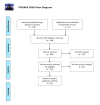Systematic Review of Serum Biomarkers in Traumatic Brain Injury
- PMID: 34522534
- PMCID: PMC8428323
- DOI: 10.7759/cureus.17056
Systematic Review of Serum Biomarkers in Traumatic Brain Injury
Abstract
Traumatic brain injury (TBI) is responsible for the majority of trauma-related deaths and is a leading cause of disability. It is characterized by an inflammatory process involved in the progression of secondary brain injury. TBI is measured by the Glasgow Coma Scale (GCS) with scores ranging from 15-3, demonstrating mild to severe brain injury. Apart from this clinical assessment of TBI, compendiums of literature have been published on TBI-related serum markers.Herein we create a comprehensive appraisal of the most prominent serum biomarkers used in the assessment and care of TBI.The PubMed, Scopus, Cochrane, and Web of Science databases were queried with the terms "biomarker" and "traumatic brain injury" as search terms with only full-text, English articles within the past 10 years selected. Non-human studies were excluded, and only adult patients fell within the purview of this analysis. A total of 528 articles were analyzed in the initial search with 289 selected for screening. A further 152 were excluded for primary screening. Of the remaining 137, 54 were included in the final analysis. Serum biomarkers were listed into the following broad categories for ease of discussion: immune markers and markers of inflammation, hormones as biomarkers, coagulation and vasculature, genetic polymorphisms, antioxidants and oxidative stress, apoptosis and degradation pathways, and protein markers. Glial fibrillary acidic protein(GFAP), S100, and neurons specific enolase (NSE) were the most prominent and frequently cited markers. Amongst these three, no single serum biomarker demonstrated neither superior sensitivity nor specificity compared to the other two, therefore noninvasive panels should incorporate these three serum biomarkers to retain sensitivity and maximize specificity for TBI.
Keywords: biomarkers; glial fibrillary acidic protein; neuron specific enolase; s100 calcium binding protein b; traumatic brain injury.
Copyright © 2021, Mozaffari et al.
Conflict of interest statement
The authors have declared financial relationships, which are detailed in the next section.
Figures
References
-
- High levels of serum mannose-binding lectins are associated with the severity and clinical outcomes of severe traumatic brain injury. Yu W, Le HW, Lu YG, Hu JA, Yu JB, Wang M, Shen W. Clin Chim Acta. 2015;451:111–116. - PubMed
-
- The prognostic value of plasma nesfatin-1 concentrations in patients with traumatic brain injury. Wu GQ, Chou XM, Ji WJ, et al. Clin Chim Acta. 2016;458:124–128. - PubMed
-
- Assessment and prognosis of coma after head injury. Teasdale G, Jennett B. Acta Neurochir (Wien) 1976;34:45–55. - PubMed
-
- Acute phase response after fatal traumatic brain injury. Ondruschka B, Schuch S, Pohlers D, Franke H, Dreßler J. Int J Legal Med. 2018;132:531–539. - PubMed
Publication types
Grants and funding
LinkOut - more resources
Full Text Sources
Miscellaneous

